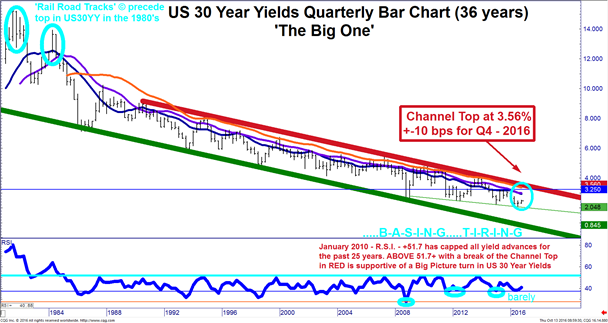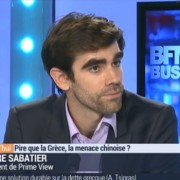Welcome to the « ugly period »…
US Election: The ‘ugly period’ is drawing nearer
- Markets under attack from regulators, political witch hunting and ignorance
- The flawed policy is to maintain elevated and overvalued stock markets
- Volcker sought a policy based on stable inflation and non-inflationary employment
- Fed’s model entails no external policy considerations – it’s purely US based
- Fed model was not designed to pay cognizance to capital markets
- Fed policy is still based on an absolutely outdated 1970s model
- Policy should aim to heal the economy, not keep cronies in situ
- Productivity is crowded out by buybacks which enrich CEOs and shareholders
- The root of the problem is not too much immigration and certainly not free trade
It’s more and more evident that we finally have arrived at an inflection point for political and economic agendas which diplomatically have made little impact and which in reality have set up one of the worst disequilibriums since World War 2. Markets, as distributors of goods, money and wealth are under attack from regulators, political witch hunting and a fundamental misunderstanding of how society needs to be shaped in order to sustain and improve productivity.
The policy, at all costs, is to maintain elevated and overvalued stock markets relative to a policy which caters and anchors long-term growth. Recently in New York I had the pleasure of hearing and listening to former Fed chair Paul Volcker, who stands out compared to the bunch of lemmings nowadays placed in central banks. Volcker’s central thesis and premise for central banking was to secure long-term plans and a vision for the economy through the Humphrey Hawkins mandated 1970s policy based on « stable inflation » and non-inflationary employment.
On this day, 38 years ago, Jimmy Carter signed the
Humphrey Hawkins Act into law. Pic: Wikimedia Commons
Attending the same conference was former Fed governor Walsh, who is the best speaker I have heard and the most honest, but his main line for me was pointing out that the very Fed model on which the whole world is basing its « cost of capital » was built in the 1970s. Further, there’s three major flaws in today’s world and is entirely a domestic US economic model meaning there were originally were zero external factors inherent in it!
Think about the fact that in a world of globalisation there is zero impact from non-domestic impulses! Crazy I know, but don’t worry – the Fed has added one line to the model: external trade! Furthermore and even more stunning is that the Fed also paid no heed to capital markets! Seriously! Yes, as the model was built in the 1970s the external trade and capital market was small relative to GDP. Fast forward to 2016 and we operate and predict the future path of Fed policy by a 1970s model which has been changed with small lines to include capital markets and external trade! No wonder a three year old is better a predicting growth, inflation and the impact on the economy than 150 PhDs at the Fed…..
The Volcker/Walsh message was pretty clear. Don’t abandon working communication and favour finding tools and visions which will help the economy heal over keeping financial markets and their powerful lobbies in place. Volcker had no time for where stocks go and he says it should be a derivative of the economy not a hindrance to growth. Attending Volcker and Walsh speeches was without a doubt this year’s intellectual highlight and a welcome antidote to current Fed chair Janet Yellen and and her European Central Bank counterpart, Mario Draghi who make my eyes glaze over inside 30 seconds when they talk in public …
The academic credentials of them both are impeccable but they were educated in the…. 1960s and 1970s a time of big business and a Fed model correctly reflecting a closed US economy. We need younger central bankers, the Walsh’s of the world to replace the last World War II generation not out of disrespect but out of a need to deliver a policy response which measures up. To a world dying to unleash the biggest pent up of productivity and investment ever relative to GDP.
During my speeches I love to point out that we have the lowest productivity ever in history and that productivity and average economic intelligence or CPU&IQ are highly correlated. Then I make the audience deduct the offending conclusion that they are the stupidest generation ever! So much for smooth talking Saxo Banks clients 🙂 This, however is not my premise, instead I believe that productivity is being crowded out by buyback programmes which makes the CEO and shareholders rich. What they also do is tax future growth and investments as they are supported by never ending financial incentives to keep going through too low market clearing cost of capital which distorts the market based economy.
Recovery, when it comes, will involve the biggest
productivity upsurge ever. But first, « the ugly period »
When – and I mean when – the recovery comes it will be through the biggest step up in productivity since the great industrial revolution but for this to happen we need to go through what I now coin the « the ugly period », with the subtitle « don’t fight ugly people, they have nothing to lose » The ugly period is when the pendulum swing of the socioeconomic agenda moves to extremes opposites of the period preceding it. The 1960s and 1970s (the birth of the Fed model years) was anti-war and pro peace and love (and a lot of drugs and rock and roll).
This new once in a generation change is the attempt to reverse the 1989 Berlin Wall fall – the fall was the peak of globalisation and the « democratisation » of Eastern Europe and part of Asia. This is what we need to understand the context in which we analyse the election in the US and as well as European developments in 2017. The voters think they need closed borders, fewer trade deals and less banking.
The problem, however, is that as much as the socioeconomic challenge on inequality is not fair but also needed, the root of the problem is not too much immigration and certainly not free trade. Instead it’s the Fed models of the world and policies in place since Alan Greenspan in the aftermath of president Reagan destroyed any accountability for central banks and in the process politicians through the constant pursuit of a policy which dictated lower interest every time a bump in the road came up.
This almost coincided with Reagan overspend – I know Reagan is a hero to many of you liberal- minded people, but he is THE ONE who taught us to spend money we didn’t have.
The economic setup: Reagan was the real sinner
When you have a political will to spend money you don’t have, a central bank regime which believes less expensive money is the solution to all problems, and ultimately a 24/7 emergency crisis mood, you end up where we are today: In a world with highest stock market capitalisation ever (which less than 10% of the world population owns), the lowest inflation, growth and productivity and a need for voters to see change.
That’s the real economic agenda, and it’s why I am the most positive I have been in my career. We have exhausted all policy options, spend all the money we didn’t have and now finally the voters got fed up. The next move is as said the ugly one – the move away from where we need to go which is towards more free trade deals, more open borders and more tolerance. The world is challenged not by those issues, but by how the socioeconomic system has failed to deliver equal access to education, credit, resources and the future.
The trading environment will be one of much higher volatility, more two-way direction, and potentially initially with less expected returns for ALL asset classes. This a mathematical necessity as we have had excess returns on financial assets and subpar on real tangible asset like infrastructure, education and employees. The excess returns will be in any country or product focused on delivering productivity, which means away from real estate and banking, towards education and infrastructure.
I personally think the best performing sector the next ten years will be education and coaching of employees as the survivors of this generational shift will be the ones willing to invest in people and vision. Imagine that – instead of sitting around waiting for the next Fed, BoJ and ECB meeting , companies and politicians need to focus on investment, people and outlook. Where does that leave Saxo Bank’s overall macro perspective? We see Q4 and Q1 as maximum intervention points as the Fed will want to hike in December, to gain credibility with market.
The cost of capital will rise with it due to the hike and due to the new « manipulation » of fixed 10-year yields initiated by the Bank of Japan (helicopter money through the back door), the US dollar will head to new highs and in fixed income 5-yr to 30-yr yields will test the multi-year long-term trend neckline.
Source: Tag.com
Commodities will have two opposing forces – a stronger US dollar will reduce their attractiveness but inflation expectations will rise due to China now exporting inflation and late cycle wage pressures. Fed hiking and Clinton becoming president will increase the odds of recession to 70% and that recession will have no central bank response, which will mean « helicopter money' » from Japan and the ECB for sure, but probably also the Fed.
So in other words, in the next few quarters play defensively as a stronger US dollar kills returns, when recession probability increases its’ back to short US dollar, commodities and inflation hedges as the policymakers have one last dance with intervention before failing.











Laisser un commentaire
Participez-vous à la discussion?N'hésitez pas à contribuer!